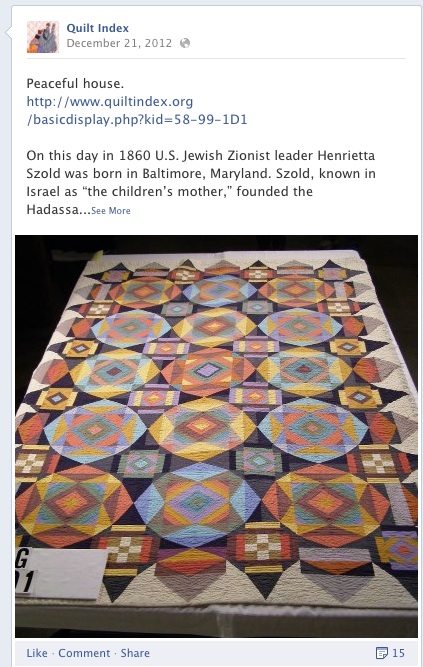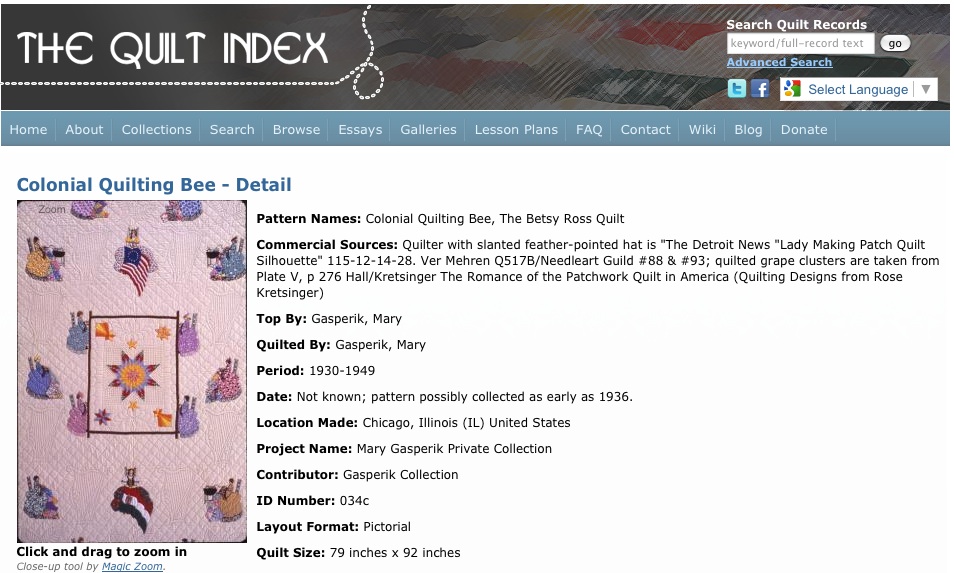Happy New Year, everyone! Our twentieth anniversary year has begun!
We look forward to sharing ongoing traditions with you in 2013, like our annual quilt contest, (posting soon) and our Quilters Take Manhattan event (Save the Date for September 28), and new ones like a special quarterly newsletter for members only, and our very first conference on quilts and oral history (Save the Date for July 20 in Herndon, Virginia).
 Also new this year, I’ll be sharing my series On this Day in History Quilts. Since August of 2011, I’ve been curating a series of posts which appear on The Quilt Index and Quilt Alliance Facebook pages on most weekdays. I scour history websites for events that happened on that particular day–from weather to war to religion to popular culture–and then try to match that event with a quilt documented in The Quilt Index, a joint project of the Quilt Alliance, MATRIX: The Center for Humane Arts, Letters and Social Sciences Online at Michigan State University and the Michigan State University Museum.
Also new this year, I’ll be sharing my series On this Day in History Quilts. Since August of 2011, I’ve been curating a series of posts which appear on The Quilt Index and Quilt Alliance Facebook pages on most weekdays. I scour history websites for events that happened on that particular day–from weather to war to religion to popular culture–and then try to match that event with a quilt documented in The Quilt Index, a joint project of the Quilt Alliance, MATRIX: The Center for Humane Arts, Letters and Social Sciences Online at Michigan State University and the Michigan State University Museum.
This year, the On this Day in History Quilts series will originate here on the Quilt Alliance blog with links to my sources, so you can explore the story even further. I’ll continue to share an abbreviated version of these posts to our Facebook pages as well as my Pinterest boards, where you can see each month’s posts in a fun patchwork layout.
In 2012 the On this Day in History Quilts series profiled quilts made by alleged vampires, log cabin quilts made in Thailand, and quilts made in Dick Van Dyke’s hometown–all documented in The Quilt Index by museums, state quilt documentation groups, guilds and private collectors. With more than 53,000 records of quilts and quilt-related ephemera in The Quilt Index, my hope with this series is to create an inviting path into this unparalleled resource that all quilt enthusiasts should know about. So please subscribe and share!
On this Day in History Quilts for January 1:
On this day in 1752 Elizabeth (Betsy) Griscom was born in Philadelphia to Quaker parents, the eighth of seventeen children. She married fellow upholstery trade apprentice John Ross, but lost him in the American Revolutionary War after only two years of marriage. Popular legend tells of Betsy making the first American flag after George Washington visited her workshop. This account originated from Betsy’s grandson who presented the story in a paper to the Historical Society of Pennsylvania in 1870. Most scholars agree that Ross was not actually the maker of the first flag, but historical records document payments made to her for flagmaking around this time.
From About.com Women’s History website:
Even if she did not make the first flag — even if the visit by George Washington never happened — Betsy Ross was an example of what many women of her time found as the reality in time of war: widowhood, single motherhood, managing household and property independently, quick remarriage for economic reasons (and, we can hope, for companionship and even love, too).
 Hungarian immigrant Mary Gasperik made the quilt featured above (detail view) between 1930-1949 in Chicago, Illinois. The official title of the quilt is Colonial Quilting Bee, but Gasperik’s family members call it the Betsy Ross Quilt, because this masterpiece includes depictions of a Hungarian quilter working on a flag opposite an Colonial quilter working on an early American flag. Don’t miss all of the detail images of this quilt linked at the bottom of the Basic Display Page for this record in The Quilt Index. “Grand-daughter Susan Salser began this research effort in 1991, after she and her two sisters divided up the quilts which belonged to their mother (Elsie Gasperik Krueger) who died in 1988. Her ongoing research has been fruitful and interesting.” What a treasure!
Hungarian immigrant Mary Gasperik made the quilt featured above (detail view) between 1930-1949 in Chicago, Illinois. The official title of the quilt is Colonial Quilting Bee, but Gasperik’s family members call it the Betsy Ross Quilt, because this masterpiece includes depictions of a Hungarian quilter working on a flag opposite an Colonial quilter working on an early American flag. Don’t miss all of the detail images of this quilt linked at the bottom of the Basic Display Page for this record in The Quilt Index. “Grand-daughter Susan Salser began this research effort in 1991, after she and her two sisters divided up the quilts which belonged to their mother (Elsie Gasperik Krueger) who died in 1988. Her ongoing research has been fruitful and interesting.” What a treasure!
Sources:
http://womenshistory.about.com/od/rossbetsy/a/betsy_ross.htm
http://en.wikipedia.org/wiki/Betsy_Ross
Posted by Amy E. Milne, executive director of the Quilt Alliance
